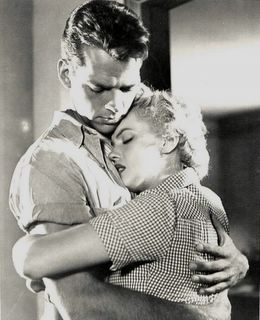Clash by Night
Clash by Night is one of five films offered by Warner Bros. in the new Film Noir DVD Box Set #2. It comes out today. The movie is absolutely not a film noir by any definition. Any definition. Instead, it's a somewhat unseemly melodrama about a love traingle, an adaptation of a Clifford Odets play that riffs on similar themes to "Streetcar Named Desire." Fritz Lang directs rather anonymously, and no attempt has been made in the adaptation to make the film less theatrical or "stagey," but it does feature some nice performances and some sharp dialogue.
It's just, you know, it has nothing to do with film noir, really, and it's being sold in a Film Noir box set. Which is kind of strange. I guess it just has a good film noir kind of title.
That's Marilyn Monroe and Paul Andres in that still from the film, but don't be fooled. They're minor supporting characters. It's just that, with these old 50's movies, it's not easy to find a quality photo online. But if Marilyn Monroe's in the movie, even if it's just one scene, you'll be able to find tons of images and reproductions.
The real stars are Barbara Stanwyck, Paul Douglas and Robert Ryan. Stanwyck plays Mae, a complex and troubled woman returning to her home town after 10 years of failed romances and lost ambition. Andres plays her brother, who takes her in, and Monroe plays his girlfriend Peggy.
Douglas is Jerry, the kindly, heavy-set lug who falls in love with Mae, and Ryan is Jerry's best friend Earl, a boorish loudmouth drunk.
Mae's the sort of woman who craves comfort and security, and Jerry seems to live surprisingly well for a self-employed fisherman, so despite some initial reluctance, she soon agrees to become his wife. Unfortunately for Jerry, she's also the sort of woman to grow bored easily, and it's not long before the company of woman-hating projectionist Earl starts to sound pretty good.
Talk about being crushed by inertia! More than five minutes of stasis and Mae's bouncing off the walls. I suppose you could say the film's depiction of a restless dreamer is over-the-top and almost surreal. In one scene, Mae turns on Earl at the exact moment when their love is realized. He proves his devotion to her and BAM!, she's ready to drop him. But the performances (particularly by the reliably fierce Stanwyck) are so convincing, so utterly devoted to the material, that it works in spite of its overenthusiasm.
So I guess that's how they justify it as a noir. It's about a woman who done done some guy poor sap wrong. In a way, it's a similar character to the one Stanwyck played in Billy Wilder's somewhat definitive noir classic Double Indemnity, although here she's less conniving and more befuddled.
And, of course, no one tries to kill anybody. Jerry comes somewhat close, when he discovers that Earl's been having relations with his wife, but he stops short of committing any actual violence. He's a pretty sensationally good guy, and Odets and the adaptation by screenwriter Alfred Hayes really punishes him for his kindness. The story seems to insist that not only do nice guys finish last, but they deserve to for never standing up for themselves. Maybe Mae would respect Jerry, and maybe Earl would respect Jerry, if he weren't such a doormat.
It's kind of an interesting perspective, highlighted by the film's observation that women tend towards men who behave violently towards them. Monroe's Peggy is seen being mock strangled by her boyfriend, and he occasionally will threaten her verbally with a beating or worse. As well, characters constantly read news reports about violence towards women and sometimes even young children. (In one scene, Jerry's father wonders aloud about the remains of a 4 month old baby found under a bridge).
This is where the similarities to Streetcar kind of come into play. The whole notion of male violence as somehow attractive to women, as neccessary in the formation of animal lust, runs through the entire film. In the scene where Earl and Mae first come together, Ryan wears a decidedly Kowalski-esque pant and wife-beater ensemble. (In what must have been considered provocative at the time, Stanwyck slips her hand inside Ryan's shirt as they kiss, rubbing his bare back). And Jerry, of course, is asexual, the kind of fat oaf who declares loudly, without a hint of self-aware irony, that he "could drink beer all night!"
It's one of those ideas that runs through a lot of the films of the 50's. I can't help but see it as a counter-stream to all the newfound feminist leanings in a lot of younger women. When society's women started to reconsider their traditional roles, and the way their lives neccessarily developed, these films presented an alternative history of womanhood, based not on serving men in the household but on manipulating them for money, power or privilege.
Mae knows she's "bad," because her entire life has been about serving herself, and even though the film ends in a reconciliation and apology, there are lingering doubts about whether she can control her selfish, wild impulses and remain settled down. It was, after all, this exact choice, between the fierce individuality of rebellion or marriage and family, that spurned the feminist revolution in the first place.

1 comment:
Hey I just saw the movie over the weekend with my husband. After reading a New Yorker article, I insisted we watch as many Stanwyck films as possible. I kept saying "This isn't really noir" and "This reminds me of Streetcar". So your comments resonated with me, and yes, the message is pretty anti-feminist! Great, interesting film, though, Monroe and Stanwyck are great--all the acting's great even though much of the dialogue is hamfisted.
Post a Comment